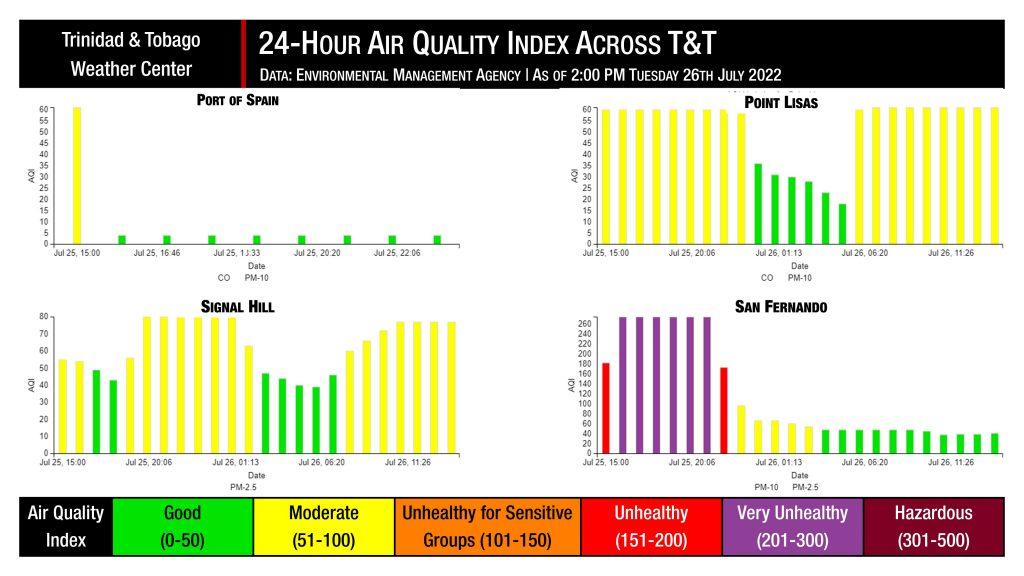Saharan Dust levels are forecast to continue fluctuating between mild and moderate levels across Trinidad and Tobago until late Sunday, when a moderate to high-concentration dust surge moves across the region.
What you need to know
— Saharan Dust Surges: The next significant dust surge is forecast to arrive across the Lesser Antilles and Trinidad and Tobago by late Sunday, July 31st, 2022. Another moderate surge is forecast by late Thursday, August 4th, 2022.
— Impacts: Air quality levels across Trinidad and Tobago will vary between good and moderate through the forecast period. Periodic rainfall will also lead to air quality improvements in localized areas.
— What Should You Do: Sensitive groups will have brief periods during the upcoming forecast period where good air quality is anticipated. However, they should take the necessary precautions during dust surges. The general population will remain unaffected.
Current AQI Levels Across T&T

The Environmental Management Agency (EMA) air quality monitoring stations at San Fernando, Port of Spain, Point Lisas, and Signal Hill have all recorded good to moderate air quality levels over the last 24 hours. At San Fernando, air quality dipped between unhealthy and very unhealthy levels late yesterday (Monday) due to localized pollution such as a nearby fire.
These measurements are based on PM2.5 (particulates the size of 2.5 micrometers and smaller, usually associated with increases in Saharan Dust, vehicle exhaust, and smoke) and PM10 particulates.
Over the last 24 hours, visibility remained near or above ten kilometers at the Piarco International Airport and A.N.R. Robinson International Airport at Crown Point, Tobago.
Saharan Dust Forecast

Ongoing Surge: Through The Weekend
Saharan Dust levels are mild to moderate across Trinidad and Tobago, with higher concentrations north of the country. Fluctuating concentrations are forecast through Sunday, July 31st, 2022, due to periodic troughs and weak tropical waves.
These troughs and tropical waves are forecast to produce intervals of showers and isolated thunderstorms, with brief air quality improvement. Still, air quality levels will vary from good to moderate, with the visibility dropping to eight kilometers outside of shower or thunderstorm activity.
Tropical Wave 24 on Sunday will usher in a new Saharan Dust surge into the upcoming week.
Surge #2: Late Sunday, July 31st, 2022
Following the passage of Tropical Wave 24 and the modulation of the Intertropical Convergence Zone towards T&T, a moderate to a high-concentration surge of dust is set to arrive by early Sunday, July 31st, 2022.
Air quality levels will dip to moderate, with visibility dropping between six to eight kilometers outside of shower or thunderstorm activity. Improvement is forecast by Wednesday, August 3rd, 2022.
Surge #3: Late Thursday, August 4th, 2022
A moderate concentration surge of dust is set to arrive by late Thursday, August 4th, 2022.
Higher concentrations of dust are forecast to remain north of Trinidad and Tobago
Air quality levels will vary between good and moderate, with the visibility dropping as low as eight kilometers outside of shower or thunderstorm activity.
What does this mean for you?


The air quality will be degraded through the forecast period. During high traffic periods, particularly between 6:00 AM and 9:00 AM, and again from 3:00 PM through 6:30 PM, air quality may be further reduced in localized areas.
According to the Trinidad and Tobago Meteorological Service, “the 2022 Saharan Dust Haze Season is likely to peak from June to August with the number of Saharan dust haze days expected to increase significantly. The duration of the plumes of Saharan dust haze visiting both islands is also likely to be more prolonged than earlier in the year, with increased odds for higher dust haze concentration during plumes visitation.”
We’re in a period where the Intertropical Convergence Zone and tropical waves may shield Trinidad and Tobago from the Saharan Dust events. While Tropical Waves play a notable role in moving dust across the Atlantic and the Eastern Caribbean, these periodic tropical waves also improve air quality.
The concentration of the dust that follows the wave depends on its strength as it moves off the West African Coast. This is because of stronger thunderstorms across Central Africa. As strong winds move downward and outward from these thunderstorms, the wind kicks up dust as it moves across parts of the Saharan Desert and transports it into the upper atmosphere. This “plume” of dust follows the axis of the wave as it progresses westward into the Atlantic.
Dust that makes it into the upper levels of the atmosphere can then get transported across the Atlantic Ocean. The plumes of dust eventually affect the Eastern Caribbean.
Larger, more concentrated plumes of Saharan dust begin in April and continue through November.











